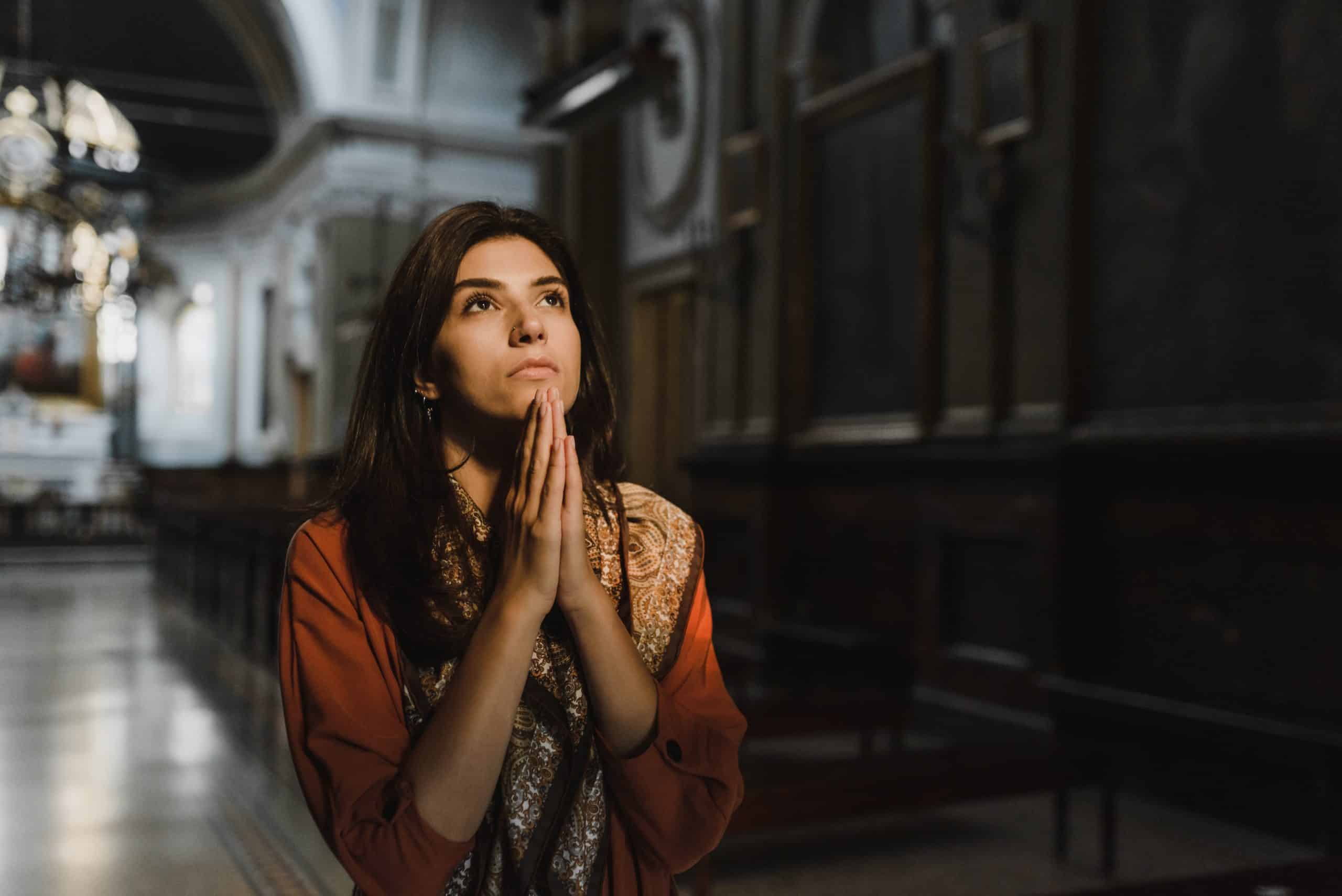Two common questions I had growing up as a Catholic were: “What is prayer?” and “How do I pray?” Fast-forward to today, when I am an ordained priest. And whether I’m on a retreat, at church after Mass, or really just about any other place (including getting a drink with friends!), I get these same questions.
Why do these questions keep coming up? Because they are great questions! They speak to our longing to grow closer to God, to be in a relationship. Prayer is an essential means to cultivating our relationship with God.
So let’s explore the fascinating topic of prayer. This article will explore both of these essential questions: What is prayer? And how do I pray?
What is prayer?
To begin, what is prayer? A lot of people understand prayer as asking God for things, what is often called petitionary prayer. Throughout Christian history, believers have encouraged each other to pray for their own needs as well as the needs of others. A mother prays for the healing of her sick child; a church prays for the comfort and security of a war-torn nation; a child asks for a good grade on a test, while an elderly person asks that God grant them a peaceful death. We pray for all sorts of things: safe travel, good physical health, financial security. At its best, this form of prayer acknowledges our limitations and our real need for God.
But can prayer look differently? As a kid, I remember asking my mom what prayer was and she had a helpful response: prayer is a conversation with God.
When we pray, we are entering into a conversation with God. We are building up and engaging in a relationship with God. We are living out our deep desire to grow closer to God and to receive what God longs to give all of us: God’s unconditional love, which is always available, always freely offered, and always life-giving.
Another helpful way of understanding prayer comes from the Jesuit theologian Walter Burghardt, who once expressed contemplation/prayer as “taking a long, loving look at the real.” Let’s break this definition down into parts.
First, prayer begins with taking a long look. It’s looking at reality like slow-motion cameras at a sporting event. We get the chance to slow down and to take a closer look, which may reveal to us things we might have otherwise missed in our fast-paced lives.
Second, prayer is also a long, loving look. When I reflect on reality, do I look with harsh, judgmental eyes, or with the loving, tender, and merciful eyes of God?
Lastly, in prayer we look lovingly at the real: the reality of my life and the world. We start with reality because God does so through the Incarnation. God undertakes the work of salvation not by fleeing human reality, but by entering into it. In the ultimate act of solidarity, God became one of us in the person of Jesus. And Jesus experienced all that reality encompasses: from joy and laughter to suffering and death. So we know that God can hold the messiness of our reality and of our world. God can handle whatever we express in prayer. Because love holds all things.
How do I pray?
So prayer is a conversation with God. This understanding of prayer gives me both a great sense of freedom…and nervousness.
I feel free because prayer does not have to be a formula. I don’t have to “have it all together” when I take time to pray. In fact, sometimes I may not know what to say at all. I may be at a complete loss for words. Thankfully the Church has collected and provided prayers over its long history to help us express to God the deepest parts of our heart. Just think of the Our Father, given to us by Jesus himself. Or the Hail Mary. These prayers remind us of Jesus’ reassurance to be direct in what we are seeking and that sometimes we don’t need to use so many words.
But I also feel nervous about prayer, since prayer is not limited to following a single formula. All kinds of doubts and questions can come to my mind. “Am I doing this right?” “Does God really care about what I have to share?” “My life isn’t as bad as others. God has enough to deal with.” But where are these feelings coming from? Certainly not from God! We know that God wants to be in relationship with us, and always welcomes our prayers.
So let’s not forget the other side of this relationship. If prayer is supposed to be a conversation, we need to remember that it should include both speaking and listening. This may seem obvious, but how often do we forget it! How often do I jump into prayer just to list all the intentions I have and the people I want to pray for, and then I end with a sign of the cross and move on!
Prayer, then, is the courage to listen to the gentle voice of love. Listening means allowing God space to speak to us: through the quiet of prayer, in our own deep desires, through the Scripture, or through the words of someone meaningful in our lives. As in any relationship, I am invited not only to speak, but also to listen with an open mind and heart.
Tips for Praying
There is no simple formula for praying, but here are a few tips for preparing yourself to enter into prayer.
First, what we do before praying is very important. Usually it’s not helpful to rush into prayer. Perhaps spend a few moments quieting down and settling into a prayerful and comfortable position.
Second, finding a good, comfortable space where you are free of distractions can make a real difference. Silence and solitude can help us focus on reading a Scripture passage, or looking back on moments from my day/life, and then reflect on how God may be speaking to me through them. A quiet place can help with that deeper listening to God’s presence, as well as notice our response.
Lastly, let’s admit that we might not always be able to set up for a good prayer period. We might not have time to quiet down and find a good, comfortable space. But we can trust that God meets us where we are. That means God can speak to us in the noise and confusion of our day. If you only have time to stop for a moment, call to mind God’s presence, and speak a petition…that’s prayer. And God delights in it!
Methods of Prayer
Over the centuries, the Christian understanding of prayer has developed and deepened. Through all those years, the Catholic Church has discovered that there’s no one-size-fits-all method of prayer. As a result, several different methods of prayer have been experienced and developed, which countless numbers of people have benefitted from in their journey of faith.
Here are a few classic methods of prayer that you might want to investigate more and consider putting into practice in your own prayer life.
- The Rosary: This popular devotional prayer invites us to meditate on the saving mysteries of Jesus’ life and the faithful witness of Mary, our Mother in faith.
- Lectio Divina: In this prayer of “divine reading,” we listen to how God speaks to us through slowly reading and contemplating Scripture or other texts.
- Centering Prayer: We focus silently on a sacred word that prepares us to receive the gift of contemplative prayer, prayer in which we experience God’s presence within us.
- Ignatian Contemplation: We use our imagination to place ourselves in a scene from Scripture using all our senses and take notice of how God may be speaking to us.
- The Ignatian Examen: An opportunity for us to prayerfully review our day in the presence of God.
*****
When I was a novice about to start my 30-day silent retreat doing the Spiritual Exercises of St. Ignatius of Loyola, my Director of Novices encouraged me to start each prayer period by first imagining God gazing upon me with loving eyes. And he said to do this for the length of an “Our Father” (which, said at a gentle pace, can be about 30 seconds). That was the context from which everything else flowed.
Prayer is about being in relationship with God. It’s not always easy, but it can be full of grace. When we take a long, loving look at the real we have the opportunity to behold ourselves and the world as God does—with tender mercy, compassion, and love. Knowing the truth of God’s love for us in prayer can be a game-changer.
God is always reaching out to us. Prayer is our response.


